

Arctic- Inuit. Myths and Folklore Wiki. Ashanti Mythology is the lore of the Ashanti people of Ghana. the most important god in the pantheon of the Ashanti is Nyame (also Nyankopon), the omniscient, omnipotent sky god.

His wife is Asase Ya and they have two children, Bia and Anansi. Asase Ya is an earth goddess of ferility. Anansi is one of the most important and famous gods of Ashanti lore. Folklore character. Ananse, also known as Anansi, Aunt Nancy, Anancy, Hapanzi, Nanzi, name given to an Akan character who has become famous throughout Africa, the countries in the Caribbean region, and beyond because of his insight, intelligence, and wisdom.

He is one of the most-important figures in the pantheon of cultural icons among West Africans. Along with his wife, Aso, Ananse can change form and may be depicted as a human, although his normal form is a spider. According to the Asante people, who are part of the larger Akan culture in western Africa, Ananse can be a trickster—that is, a personality who teaches moral, ethical, political, or social values based on his ability to lead a person to the truth through example, puzzles, and the least-expected turns and twists of fate.
The folklore surrounding Ananse appears to be quite extensive in the African communities throughout the Americas, where he is often associated with the spider or the rabbit. Ashanti Mythology – Occult World. Myths and Folklore Wiki. Ghana population. Ashanti Empire. Type of Government The Ashanti Empire was ruled by a centralized monarchy headed by an asantehene (king).
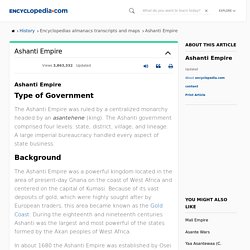
The Ashanti government comprised four levels: state, district, village, and lineage. Asante. Asante, also spelled Ashanti, people of south-central Ghana and adjacent areas of Togo and Côte d’Ivoire. Most of the Asante live in a region centred on the city of Kumasi, which was the capital of the former independent Asante state. They speak a Twi language of the Kwa branch of the Niger-Congo language family and are a subgroup of the Akan peoples. 410 Gone. Asante. The Asante (Ashanti) are the largest and most powerful of a cluster of AKAN chiefdoms of southern GHANA and IVORY COAST.
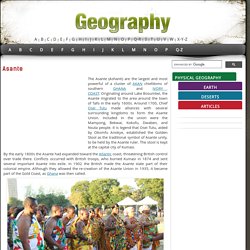
Originating around Lake Bosumtwi, the Asante migrated to the area around the town of Tafo in the early 1600s. Around 1700, Chief Osei Tutu made alliances with several surrounding kingdoms to form the Asante Union. Included in the union were the Mampong, Bekwai, Kokofu, Dwaben, and Nsuta people. It is legend that Osei Tutu, aided by Okomfu Anokye, established the Golden Stool as the traditional symbol of Asante unity, to be held by the Asante ruler. The stool is kept at the capital city of Kumasi. Description, Myth, Symbols, History, & Facts. Isis, Egyptian Aset or Eset, one of the most important goddesses of ancient Egypt.
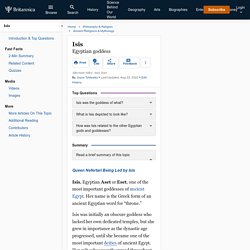
Her name is the Greek form of an ancient Egyptian word for “throne.” Isis was initially an obscure goddess who lacked her own dedicated temples, but she grew in importance as the dynastic age progressed, until she became one of the most important deities of ancient Egypt. Her cult subsequently spread throughout the Roman Empire, and Isis was worshipped from England to Afghanistan. She is still revered by pagans today. As mourner, she was a principal deity in rites connected with the dead; as magical healer, she cured the sick and brought the deceased to life; and as mother, she was a role model for all women. 11 Egyptian Gods and Goddesses. Egypt Death rate - Demographics. Death rate: 4.36 deaths/1,000 population (2021 est.)
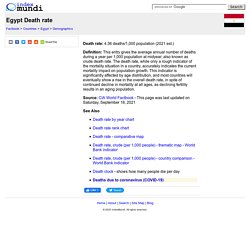
Definition: This entry gives the average annual number of deaths during a year per 1,000 population at midyear; also known as crude death rate. The death rate, while only a rough indicator of the mortality situation in a country, accurately indicates the current mortality impact on population growth. Egypt Male to female ratio, 1950-2020. Egypt - Government and society. Egypt has operated under several constitutions, both as a monarchy and, after 1952, as a republic.

The first and most liberal of these was the 1923 constitution, which was promulgated just after Britain declared Egypt’s independence. That document laid the political and cultural groundwork for modern Egypt, declaring it an independent sovereign Islamic state with Arabic as its language. Egypt - Languages. The official language of Egypt is Arabic, and most Egyptians speak one of several vernacular dialects of that language. As is the case in other Arab countries, the spoken vernacular differs greatly from the literary language. Modern literary Arabic (often called Modern Standard Arabic or al-fuṣḥā, “clear” Arabic), which developed out of Classical, or medieval, Arabic, is learned only in school and is the lingua franca of educated persons throughout the Arab world.
The grammar and syntax of the literary form of the language have remained substantially unchanged since the 7th century, but in other ways it has transformed in recent centuries. The modern forms of style, word sequence, and phraseology are simpler and more flexible than in Classical Arabic and are often directly derivative of English or French. There are also other minor linguistic groups. World Bank Climate Change Knowledge Portal. Egypt’s climate is dry, hot, and dominated by desert.
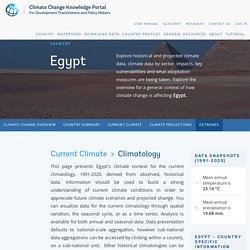
It has a mild winter season with rain falling along coastal areas, and a hot and dry summer season (May to September). Daytime temperatures vary by season and change with the prevailing winds. In the coastal regions, temperatures range between average winter minimums of 14°C (November to April) and average summer maximums of 30°C (May to October). Egypt - Settlement patterns. Physiographically, Egypt is usually divided into four major regions—the Nile valley and delta, the Eastern Desert, the Western Desert, and the Sinai Peninsula.
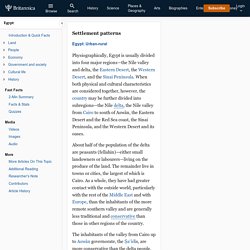
When both physical and cultural characteristics are considered together, however, the country may be further divided into subregions—the Nile delta, the Nile valley from Cairo to south of Aswān, the Eastern Desert and the Red Sea coast, the Sinai Peninsula, and the Western Desert and its oases. About half of the population of the delta are peasants (fellahin)—either small landowners or labourers—living on the produce of the land. The remainder live in towns or cities, the largest of which is Cairo. The myth and legend of Papa Legba. The most popular Vodou deity and gatekeeper to the spirit world Papa Legba is one of the loa, a group of spirits associated with daily life, in the Haitian Vodou religion and voodoo belief system.

He is probably one of the best known and most loved deities in African spirituality and is thought to stand between man and the spirit world. He is known as Lord of the Roads, God of the Crossroads, and the great communicator. He is known to have the gift of all speech, being able to talk in any human language. Legba is often depicted as an older man with a cane, dressed in tattered rags, smoking a pipe and wearing a straw hat, often with his dog by his side.
The 8 Most Important Voodoo Gods. The loa, or major divine beings of Voodoo, or Vodun, are spirits who serve as intermediaries between man and Bondye, the supreme Voodoo god. The loa, or lwa, appear in different families, including the Ghede, Petro, and Radha. They are typically considered lesser divine figures, with the supreme god being Bondye, the creator. Enslaved people in Haiti and Louisiana syncretized their loa with Catholic saints, and many of the loa have corresponding figures in Catholicism. They are called upon in ritual by Voodoo mambos or houngan, and are presented with offerings of food and drink before they are petitioned for assistance. In some African traditional religions, the orishas are worked with, in addition to or instead of the loa. Haitian mythology. Haitian Vodou (also known as Voodoo in the United States) is a syncretic mixture of Roman Catholic rituals introduced during the French colonial period, African beliefs, with roots in the Yoruba, Kongo and Dahomey mythology, and folkloric influence from the indigenous Taino Amerindians that once populated the island.
It is not found commonly anymore. Pantheon Related notions. Haiti population. Haiti Facts. History, Geography, & Culture. Haiti is bordered to the east by the Dominican Republic, which covers the rest of Hispaniola, to the south and west by the Caribbean, and to the north by the Atlantic Ocean. Cuba lies some 50 miles (80 km) west of Haiti’s northern peninsula, across the Windward Passage, a strait connecting the Atlantic to the Caribbean. Jamaica is some 120 miles (190 km) west of the southern peninsula, across the Jamaica Channel, and Great Inagua Island (of The Bahamas) lies roughly 70 miles (110 km) to the north. Haiti claims sovereignty over Navassa (Navase) Island, an uninhabited U.S. -administered islet about 35 miles (55 km) to the west in the Jamaica Channel. The generally rugged topography of central and western Hispaniola is reflected in Haiti’s name, which derives from the indigenous Arawak place-name Ayti (“Mountainous Land”); about two-thirds of the total land area is above 1,600 feet (490 metres) in elevation.